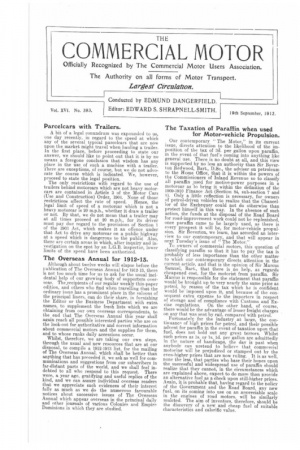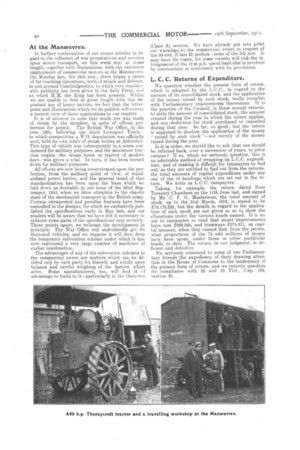Parcelcars with Trailers.
Page 1

Page 2

If you've noticed an error in this article please click here to report it so we can fix it.
A bit of a legal conundrum was expounded to Us, one day recently, in regard to the speed at which any of the several typical parcelcars that are now upon the market might travel when hauling a trailer. In the first place, before proceeding to state our answer, we should like to point out that it is by no means a foregone conclusion that wisdom has any place in the use of such a machine with a trailer. There are exceptions, of course, but we do not advocate the course which is indicated. We, however, proceed to state the legal position. The only restrictions with regard to the use of trailers behind motorcars which are not heavy motorcars are contained in Article 3 of the Motor Cars (Use and Construction) Order, 1901. None of those restrictions affect the rate of speed. Hence, the legal limit of speed of a motorcar which is not a heavy motorcar is 20 m.p.h., whether it draw a trailer or not. By that, we do not mean that a trailer may at all times proceed at 20 m.p.h., for its driver must pay due regard to the provisions of Section 1 of the 1903 Act, which makes it an offence under that Act to drive any motorcar on a public highway at a speed which is dangerous to the publi4 Also, there are certain areas in which, after inquiry and investigation on the spot by an L.G.B. inspector, lower limits of the speed have been authorized.
The Overseas Annual for 1912-13.
Although about twelve weeks will elapse before the publication of The Overseas Annual for 1912-13, there is not too much time for us to ask for the usual incidental help of our growing body of supporters overseas. Thesecipients of our regular weekly thin-paper edition, and others who find when travelling that the ordinary issue has a prominent place in the saloons of the principal liners, can do their share, in furnishing the Editor or the Business Department with extra names, to supplement the fresh lists which we are obtaining from our own overseas correspondents, to the end that The Overseas Annual this year shall again reach all possible interested parties who are on the look-out for authoritative and correct information about commercial motors and the supplies for them, and to whose ranks daily accessions occur. Whilst, therefore, we are taking our own steps, through the usual and new resources that are at our disposal, to compile a 1912-1913 list, for the mailing of The Overseas Annual, which shall be better than anything that has preceded it, we ask as well for communications and suggestions from our subscribers in far-distant parts of the world, and we shall feel indebted to all who respond to this request. There were, a year ago, gratifying and useful replies of the kind, and we can assure individual overseas readers that we appreciate such evidences of their interest fully as much as we do the numerous favourable notices about successive issues of The Overseas Annual which appear overseas in the principal daily and other journals of various Colonies and Empire Dominions in which they are studied. The Taxation of Paraffin when used for Motor-vehicle Propulsion.
Our contemporary The Motor," in its current issue, directs attention to the likelihood of the imposition of the tax of 3d. per gallon upon paraffin, in the event of that fuel's coming into anything like general use. There is no doubt at all, and this view is supported by no less an authority than Sir Boyerton Redwood, Bart., D.Sc., the adviser on petroleum to the Home Office, that it is within the powers a the Commissioners of Inland Revenue so to classify all paraffin ,used for motive-power purposes in a motorcar as to bring it within the definition of the 1909-1910 Finance Act (Section 84, sub-section 7 and 8). Only a little reflection is necessary, for owners of petrol-driven vehicles to realize that the Chancellor of the Exchequer could not do otherwise than protect himself in this way. In the absence of such action, the funds at the disposal of the Road Board for road-improvement work could not be replenished, once paraffin came to be largely used, as there is every prospect it will be, for motor-vehicle propulsion. Sir Boverton, we learn, has accorded an interview to our contemporary, and that will appear in next Tuesday's issue of " The Motor."
To owners of commercial motors, this question of classifying paraffin so that it has to pay the tax is probably of less importance than the other matter to which our contemporary directs attention in the current article, and that is the opinion of Sir Marcus Samuel, Bart., that there is no help, as regards cheapened cost, for the motorist from paraffin. Sir Marcus is responsible for the statement that paraffin would be brought up to very nearly the same price as petrol, by reason of the tax which he is confident would be imposed upon it, and because of the consequent extra expense to the importers in respect of storage and of compliance with Customs and Excise regulations. On the other hand, of course, there would be the advantage of lesser freight charges on any that was sent by rail, compared with petrol. Fortunately for the industry at large, the continuance of high prices for petrol, and their possible advent, for paraffin in the event of taxation upon that fuel, does not hold out any great terrors. Whilst such prices as Is or is. Id. per gallon are admittedly in the nature of handicaps, the day is past when anybody can pretend to believe that commercial motoring will be prejudiced or stamped out by the even-higher prices that are now ruling. It is as well, none the less, that parties who base their hopes upon the successful and widespread use of paraffin should realize that they cannot, in the circumstances which are explained above, expect to do more than provide an alternative fuel as a check upon still-higher prices. Again, it is probable that, having regard to the policy of the Government and the Road Board. any new fuel, on its coming into use on an appreciable scale in the engines of road motors, will be similarly mulcted. The aim of inventors, therefore, should be the discovery of a new and cheap fuel of suitable characteristics and calorific value.
At the Manceuvres,
In further continuation of our recent articles in regard to the influence of war preparations and services upon motor transport, we this week deal at some length, together with illustrations, with the extensive employment of commercial motors at the Manteuvres. On Monday last, the 16th inst., there began a series of far-reaching operations, both of attack and defence, in and around Cambridgeshire, to which very considerable publicity has been given in the daily Press, aid at which H.M. the King has been present. Whilst we are unable to deal at great length With this important use of heavy motors, we feel that the letterpress and illustrations which we do publish will convey a correct view of those applications to our readers.
It is of interest to note that much use was made of steam by the invaders, in spite of official preference for petrol. The British War Office, in the year 1901, following the third Liverpool Trials— to which competition a W.O. deputation was officially sent, held its own trials of steam lorries at Aldershot. This type of vehicle was subsequently in a sense condemned for military purposes, and the miniature traction engine—the steam horse or tractor of modern days—was given a trial. In turn, it has been turned down for military purposes.
All efforts are now being concentrated upon the perfection, from the military point of view, of standardized petrol lorries, and the general trend of that standardization has been upon the lines which we laid down as desirable in our issue of the 22nd Septemper, 1910, when we drew attention to the chaotic state of the mechanical transport in the British army. Certain unexpected and peculiar features have been embodied in the designs, for which we exclusively published the specifications early in May last, and our readers will be aware that we have felt it necessary to criticize some parts of the specifications very severely. Those points apart, we welcome the development in principle. The War Office will undoubtedly get its, thousand vehicles, and we suppose it will then drop the temporary subvention scheme under which it has now registered a very large number of niachines of earlier construction.
The advantages of any of the subvention schemes to the commercial owner are matters which can be decided only by each party for himself, and wholly upon balance and careful weighing of the factors which arise. Some manufacturers, too, will find it ef advantage to build to it—particularly in the three-ton (Class A) section. We have already put into print our warnings to the commercial owner in respect of the 30-cwt. (Class B) section—issue of the 5th inst. It may have its vogue, for some owners will risk the infringement of the 12 m.p.h. speed limit that is involved by construction in conformity with its provisions.
L. C. C. Returns of Expenditure.
We question whether the present form of return, which is adopted by the L.C.C., in regard to the amount of its consolidated stock, and the application of the money raised by such stock, really complies with Parliamentary requirements thereanent. It is the practice of the Council, in these annual returns, to state the amount of consolidated stock, the amount created during the year to which the return applies, and any deduction for stock purchased or cancelled during that year. So far, so good ; but the return is supposed to disclose the application of the money "raised by such stock "—not merely of the money raised during the year.
Is it in order, we should like to ask, that one should be referred back, over a succession of years, to prior returns ? If so, which we seriously question, this is an admirable method of wrapping up L.C.C. expenditure, and of making it difficult for ratepayers to find out, as they are entitled to find out from the returns, the total amounts of capital expenditure under any one of the 16 headings which are set out in the return. We write as L.C.C. ratepayers.
Taking, for example, the return dated from Treasury Chambers on the 11th June last, and signed by Mr. C. F. G. Masterman, the total amount of stock, up to the 31st March, 1912, is stated to be £75,176,222, but the details in regard to the application of such stock are not given so as to show the allocations under the various heads named. It is no use to ratepayers to read that street improvements have cost E298,642, and tramways -2574,811, on capital account, when they cannot find, from the return, what proportions of the 75 odd millions of money have been spent, under these or other particular heads, to date. The return, in our judgment, is deficient and defective.
We seriously commend to some of our Parliamentary friends the expediency of their drawing attention in the House of Commons to the inadequacy of the present form of return, and we entirely question its compliance with 32 and 33 Viet., Cap. 102, section 49.






















